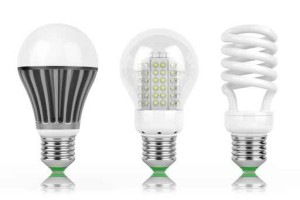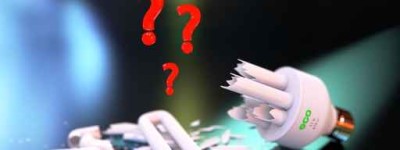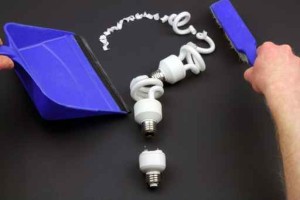Frequently I get asked which are the safest light bulb.
In short, the old style light bulbs are the best, but they are not always available.
A little history – Thomas Edison invented the first feasible light bulb in the late 1800’s. That type of bulb was used for more than 100 years and called incandescent light bulbs.
In 2007, the U.S. Federal Government outlawed the future manufacture and importing of most of these bulbs. They did this for energy savings.
“The U.S. Federal Government started phasing out incandescent light bulbs in 2012, starting with the 100-watt bulb, and then followed by the 75-watt,” explained Melissa Andresko, communications director for lighting-automation company Lutron.
As of January 1, 2014 most of the 60- and the 40-watt bulbs went away.
Now we have 3 choices of light bulbs:

LED & CFL Bulbs
1 – CFL’s – Compact Fluorescent Light Bulbs- Worst
2 – LED’s – That are Non-Dimmable-OK
3 – New Halogen Bulbs that screw into light sockets – Best
1 – CFL’s have a number of problems.
Most CFL’s create Wireless & WiFi radiation and Dirty Electricity.
CFL’s have mercury in them and have to be disposed as a hazard waste.
Mercury is very toxic. In fact, it is a neurotoxin, meaning that it harms the brain and nervous system. It is also linked to kidney and liver damage and possibly cancer. Children are especially at risk because their brains and bodies are still developing. Many health effects of mercury can be permanent.
Dentists must also take care to manage their mercury-containing dental waste. Dental offices in Washington State are required to use and maintain a dental amalgam separator.
Washington State has recently added a surcharge of $1.00 for a package of 4 bulbs to cover the cost of disposing this hazard waste.
CFL’s contain so much mercury that the EPA and state environment officials consider them to be a hazard if they break.
They cannot be placed in landfills because thousands of decaying or broken bulbs would cause noticeable mercury contamination.
CFL’s are not allowed to be thrown normal trash.
** Below are the clean-up instructions from the U.S. EPA. **
2 – LED’s tend to be better. Always buy the Non-Dimmable.
I would recommend that you buy a Dirty Electricity Meter to measure any LED’s you have.
If you don’t have a Dirty Electricity Meter to test the LED’s, purchase NON-Dimmable LED’s.
There are some NON-Dimmable LED’s, though, that still create Dirty Electricity.
ALL Dimmable LED’s will create Dirty Electricity.
3 – New Halogen Bulbs that screw into light sockets.
These new Halogen Bulbs save electricity.
They generate NO Electromagnetic Radiation.
Best option.
4 – ** If you break a CFL bulb in your home, the following are the clean-up instructions from the U.S. EPA:
Before Cleanup

1. Have people and pets leave the room, and avoid the breakage area on the way out.
2. Open a window or door to the outdoors and leave the room for 5-10 minutes.
3. Shut off the central forced-air heating/air conditioning (HVAC) system, if you have one.
4. Collect materials you will need to clean up the broken bulb:
o Stiff paper or cardboard
o Sticky tape (e.g., duct tape)
o Damp paper towels or disposable wet wipes (for hard surfaces)
o Glass jar with a metal lid (such as a canning jar) or a sealable plastic bag(s)
________________________________________
Cleanup Steps for Hard Surfaces
1. Carefully scoop up glass fragments and powder using stiff paper or cardboard and place debris and paper/cardboard in a glass jar with a metal lid. If a glass jar is not available, use a sealable plastic bag.
NOTE: Since a plastic bag will not prevent the mercury vapor from escaping, remove the plastic bag(s) from the home after cleanup.
2. Use sticky tape, such as duct tape, to pick up any remaining small glass fragments and powder. Place the used tape in the glass jar or plastic bag.
3. Wipe the area clean with damp paper towels or disposable wet wipes. Place the towels in the glass jar or plastic bag.
4. Vacuuming of hard surfaces during cleanup is not recommended unless broken glass remains after all other cleanup steps have been taken. [NOTE: It is possible that vacuuming could spread mercury-containing powder or mercury vapor, although available information on this problem is limited.] If vacuuming is needed to ensure removal of all broken glass, keep the following tips in mind:
o Keep a window or door to the outdoors open;
o Vacuum the area where the bulb was broken using the vacuum hose, if available; and
o Remove the vacuum bag (or empty and wipe the canister) and seal the bag/vacuum debris, and any materials used to clean the vacuum, in a plastic bag.
5. Promptly place all bulb debris and cleanup materials, including vacuum cleaner bags, outdoors in a trash container or protected area until materials can be disposed of. Avoid leaving any bulb fragments or cleanup materials indoors.
6. Next, check with your local government about disposal requirements in your area, because some localities require fluorescent bulbs (broken or unbroken) be taken to a local recycling center. If there is no such requirement in your area, you can dispose of the materials with your household trash.
7. Wash your hands with soap and water after disposing of the jars or plastic bags containing bulb debris and cleanup materials.
8. Continue to air out the room where the bulb was broken and leave the HVAC system shut off, as practical, for several hours.
If you have further questions, please call your local poison control center at 1-800-222-1222.
________________________________________

Cleanup Steps for Carpeting or Rugs
1. Carefully scoop up glass fragments and powder using stiff paper or cardboard and place debris and paper/cardboard in a glass jar with a metal lid. If a glass jar is not available, use a sealable plastic bag.
NOTE: Since a plastic bag will not prevent the mercury vapor from escaping, remove the plastic bag(s) from the home after cleanup.
2. Use sticky tape, such as duct tape, to pick up any remaining small glass fragments and powder. Place the used tape in the glass jar or plastic bag.
3. Vacuuming of carpeting or rugs during cleanup is not recommended unless broken glass remains after all other cleanup steps have been taken. [NOTE: It is possible that vacuuming could spread mercury-containing powder or mercury vapor, although available information on this problem is limited.] If vacuuming is needed to ensure removal of all broken glass, keep the following tips in mind:
o Keep a window or door to the outdoors open;
o Vacuum the area where the bulb was broken using the vacuum hose, if available, and
o Remove the vacuum bag (or empty and wipe the canister) and seal the bag/vacuum debris, and any materials used to clean the vacuum, in a plastic bag.
4. Promptly place all bulb debris and cleanup materials, including vacuum cleaner bags, outdoors in a trash container or protected area until materials can be disposed of. Avoid leaving any bulb fragments or cleanup materials indoors.
5. Next, check with your local government about disposal requirements in your area, because some localities require fluorescent bulbs (broken or unbroken) be taken to a local recycling center. If there is no such requirement in your area, you can dispose of the materials with your household trash.
6. Wash your hands with soap and water after disposing of the jars or plastic bags containing bulb debris and cleanup materials.
7. Continue to air out the room where the bulb was broken and leave the H&AC system shut off, as practical, for several hours.
If you have further questions, please call your local poison control center at 1-800-222-1222.
________________________________________
Future Cleaning of Carpeting or Rugs: Air Out the Room During and After Vacuuming
1. The next several times you vacuum the rug or carpet, shut off the Heating & Air Conditioning system if you have one, close the doors to other rooms, and open a window or door to the outside before vacuuming. Change the vacuum bag after each use in this area.
2. After vacuuming is completed, keep the Heating & Air Conditioning system shut off and the window or door to the outside open, as practical, for several hours.
If you have further questions, please call your local poison control center at 1-800-222-1222.

